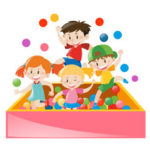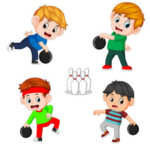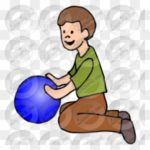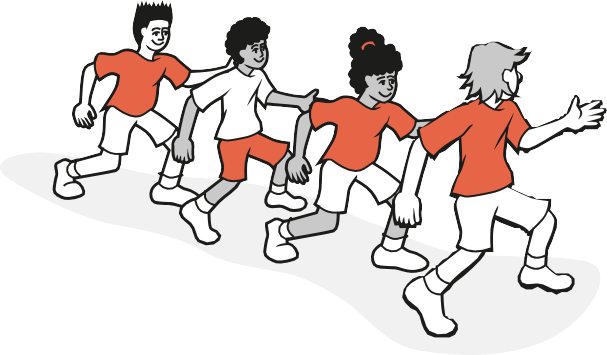
by Santosh | Jun 10, 2020 | Fitness Activity
Movement skills/concepts
Static and dynamic balance, relationships (with others), body and space awareness.
Set-up
Hard or grass surface.
Each group of four stands in a line with a leader at the front.
Activity
The group walks or jogs a short distance behind the leader. When the leader turns around, all the followers ‘freeze’ on the spot.
Any children who move or who are slow to stop collect a ‘thaw’ point.
Repeat several times – the leader can change the type of movement to skipping or galloping etc. Change the leader after several turns.
Who can avoid collecting any thaw points?
Can you see …?
- quick reactions
- using space
- tight muscles
- stable base
- eyes on leader
You could ask …
What can you do to freeze suddenly when the leader turns? Can you hold your shape for three seconds?
Variations
Vary movement: Change the type of movement after each stop, (e.g. to hopping, crawling).
Vary body shape: Leader nominates some kind of statue position, which the children assume, (e.g. ballerina, tall shape, stretched elastic).
COOL DOWN/ CLOSURE
Review Skill/Activity, stretching, and questions.
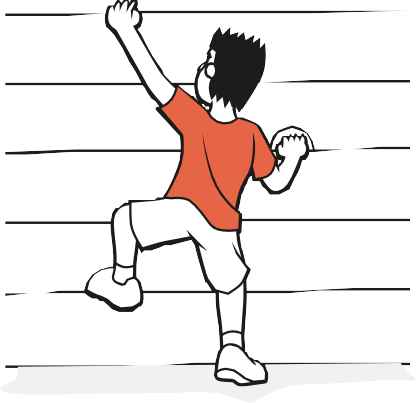
by Santosh | Jun 10, 2020 | Fitness Activity
Movement skills/concepts
Dynamic balance, climbing at different levels, on equipment, in general space and in different directions.
Set-up
- Hoops, ladder, steps, hand and foot cut-outs or animal footprints.
- Individuals or small groups start at different points of a smooth surface circuit.
Activity
Children practice the following activities in the circuit.
- Mirror games: In pairs, one person does an arm or leg action and the other mirrors this action. How fast can you move?
- Climbing steps: Make steps from equipment, or use existing steps with cut-out hand/ foot shapes, which children move over with hand/foot crawling action.
- Hoop patterns: Set up a trail of hoops which children follow on all fours, placing only one hand or one foot in a hoop at a time.Horizontal ladder: On all fours, children conduct a firefighter rescue by moving along a
- drawn ladder, or a real ladder horizontally placed, and rescuing an object (e.g. teddy/doll) at the end.
Can you see …?
• alternate, independent foot and leg action
• safe surface for hands
• frequent breaks from walking on the hands
COOL DOWN/ CLOSURE
Review Skill/Activity, stretching, and questions.
You could ask …
What did you enjoy about climbing?
Did you find any activities difficult? Why was this?
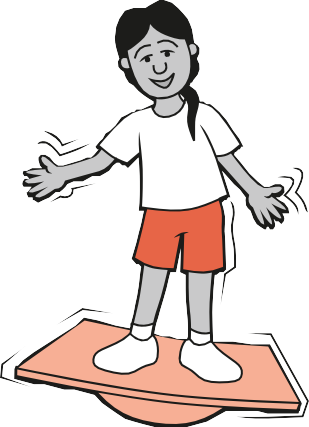
by Santosh | Jun 10, 2020 | Fitness Activity
Movement skills/concepts
Dynamic balance, static balance, space awareness, weight transfer and weight-bearing, body awareness, and relationships (with equipment).
Set-up
A variety of equipment or playground/gymnastic apparatus, such as low benches, ropes, hoops, bars, low fence, wobble boards. Also playground markings like grids, or patterns etc.
Children are spread out in a level hard or grass area.
Activity
Who can …?
• travel with only one/two/three body part(s) touching the ground – on a signal, freeze in that position and hold for three seconds
• travel around the room like a crab, or a monkey, or a bear – on a signal, freeze in that shape and hold for three seconds
• put weight on different points, (e.g. elbows, knees, head)
• put weight on different surfaces, (e.g. back, tummy side)
• move from one surface to another, (e.g. back to tummy)
• move from points to a surface, (e.g. foot to back)
• travel along lines, ropes, a line of blocks or around a hoop
• walk along a low bench/beam – stop and hold a balance for three seconds
• walk along an inclined bench
• balance on an unstable base, (e.g. wobble board)
Can you see …?
• head up – point of focus
• arms extended out to side (aeroplane arms)
• good posture – tight muscles
You can ask …
How can you keep your balance when you are walking along a line or a low bench?
Variations
Go on a balance journey: For example, travel around the room (bear walk or hopping) moving on, off, over, under and around the equipment. On a signal, balance in a certain way on the nearest apparatus (e.g. balance like a bear).
COOL DOWN/ CLOSURE
Review Skill/Activity, stretching, and questions.
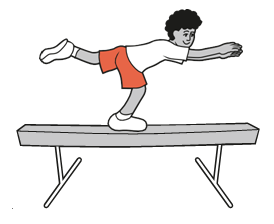
by Santosh | Jun 10, 2020 | Fitness Activity
Movement skills/concepts
Static balance, body and space awareness, and relationships (with equipment).
Set-up
Mats, benches, discs/bases, beanbags, balls, foam frisbees.
Activity 1: On-the-spot balance
Children are scattered throughout an area while standing on a disc/base, where there is also some equipment (beanbag, ball and foam frisbee).
• choose one piece of equipment and try to balance it on any body part while standing on your spot
• balance one of the objects on your head while standing on one foot and staying on your spot
• balancing only on your bottom, balance a ball between your feet while keeping your feet off the ground
Activity 2: Bench balance
Each small group of approximately three–four children stands beside a low bench. In turn, children step up onto the middle of the bench and hold a balance for
three seconds.
• vary the type of balance (e.g. shapes – wide, narrow, levels – low, medium, high and body parts – one foot, bottom, two hands, one knee)
• be creative (e.g. pose like a ballerina, Superman, a tennis player, or any other sporting or dancing star)
Can you see …?
• tight muscles
• being as still as possible
• balancing with arms extended out to side (aeroplane arms)
You could ask …
How can you keep very still when you are balancing?
What did you do to keep your feet off the floor in the sitting balance?
Variations
Combine balances: Move from one balance to another, holding each for three seconds (count ‘one thousand’ as one second).
Combine balances with travelling: Balance on one spot with one object (e.g. balance on one foot with object on head), then travel to another spot still balancing the object (e.g. walking with the object on head), then choose another balance with another object (e.g. balance on shoulders with legs off the ground balancing a ball).
COOL DOWN/ CLOSURE
Review Skill/Activity, stretching, and questions.
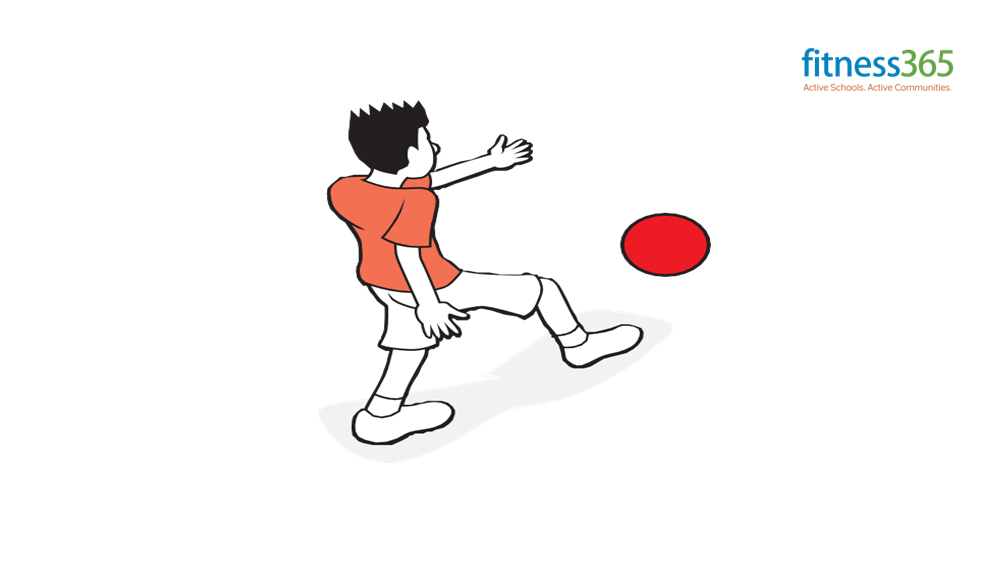
by Neetu | Jun 8, 2020 | Fitness Activity
Movement skills/concepts
Kicking a stationary ball for height and accuracy, space awareness, and balance.
Set-up
- A variety of balls for kicking, tape for shapes (targets) on wall/net.
- A level grass or hardcourt area with a wall/net around the perimeter. Children are spread out, standing 3 meters in front of the wall/net.
Activity: Can you …?
- when the ball is on the ground, place your foot underneath the ball and flick it in the air so that it hits the wall
- practice walking/running up to the ball, kicking underneath the center of the ball to the wall
- practice the above with the inside of your foot using your toes
- try to hit one of the target shapes on the wall
Can you see …?
- planting the non-kicking foot next to the ball
- striking underneath the ball
- following through
- leaning back slightly
You could ask …
Where do you need to strike the ball to lift it in the air?
How can you lift the ball in the air with your feet? Which way lets you lift the ball the highest?
Variations
Have a target competition: How many times in a row can you hit the target?
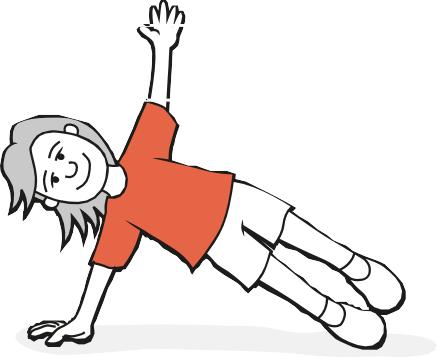
by Santosh | Jun 8, 2020 | Fitness Activity
Movement skills/concepts
Static balance, dynamic balance, body and space awareness.
Set-up
Mats.
Children, each with space on a mat, are scattered around an area with an even surface.
Activity
Can you balance …?
- on one body part, (e.g. on your side, back, front, shoulders, knees)
- as above but with your eyes closed
- while moving your weight from one body part to another part, (e.g. from one foot, to your tummy, to your back)
- two body parts, (e.g. on one hand and one knee)
- three body parts, (e.g. on one elbow, one foot, and one knee)
- as above while holding for three seconds (count ‘alligators’ or ‘thousand’ as one second)
- on two/three body parts that are on the same/different sides of the body
- at different levels – low, medium and high
- starting low, moving to a high position and finishing with a low position
- on one foot and change the position of your arms, bottom, and other foot
- while changing the position of your base, (e.g. start with a balance on two feet, move one in front of the other, lower your level, now bring feet close together and raise your level)
- while traveling through space in any way you choose (e.g. walking, hopping, like a robot), then, on a signal, creating a static balance, (e.g. balance on different body parts, making different shapes and at different levels)
Can you see …?
• tight muscles
• balancing like a statue – not moving
You could ask …
Which sort of balance gave you the best base of support? Which sort of balance was easy to hold for three seconds?
Variations
Combine balances: Create your own balance story, (e.g. change from a one-body-part balance to a three-body-part balance to a four-body-part balance). Hold each one for three seconds.
Add levels and shapes to balance story: For example, move from a one-body-part balance at a high level, to a two-body-part balance in a wide shape, to a three-body- part balance at a low level.
COOL DOWN/ CLOSURE
Review Skill/Activity, stretching, and questions.









